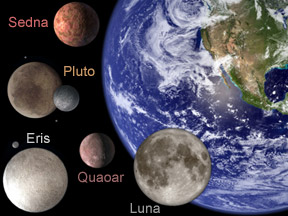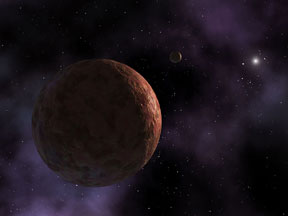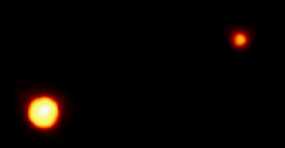This is an artist's impression of the icy Kuiper belt object 2002 LM60, dubbed "Quaoar" by its discoverers.
Click on image for full size
Courtesy of NASA and G. Bacon
An Icy New Planet?
News story originally written on October 9, 2002
Scientists have found something new in the solar system! They found a far-away object far beyond Pluto by looking with the Hubble Space Telescope.
The scientists call their discovery Quaoar. It is 4 billion miles from Earth and is the furthest object in the solar system to ever to be seen with a telescope. Like Pluto, Quaoar is in the Kuiper Belt, an icy bunch of rubble beyond Neptune. Quaoar is about half the size of Pluto and its orbit around the Sun is nearly a circle.
Last modified October 9, 2002 by Lisa Gardiner.
You might also be interested in:

Pluto is a frigid ball of ice and rock that orbits far from the Sun on the frozen fringes of our Solar System. Considered a planet, though a rather odd one, from its discovery in 1930 until 2006, it was
...more
The Hubble Space Telescope (HST) is really neat! It was first launched in 1990, but scientists started building it in the 1970's! We have found all kinds of objects like stars, nebulae and galaxies. The
...more
Do you know what a planet is? Guess what... astronomers are not quite sure what a planet is! Mercury, Venus, Earth, and Mars are the planets closest to the Sun. They are definitely all planets. They are
...more
There are lots of small worlds at the edge of our Solar System. They are made of ice and rock. They are further away from the Sun than most planets. They are further away than the 8th planet, Neptune.
...more
Pluto has been officially demoted from its status as a planet. The International Astronomical Union (IAU), at a meeting in August 2006, voted on their first "official" definition of a planet.
...more
It was another exciting and frustrating year for the space science program. It seemed that every step forward led to one backwards. Either way, NASA led the way to a great century of discovery. Unfortunately,
...more
The Space Shuttle Discovery lifted off from Kennedy Space Center on October 29th at 2:19 p.m. EST. The sky was clear and the weather was great. This was the America's 123rd manned space mission. A huge
...more















